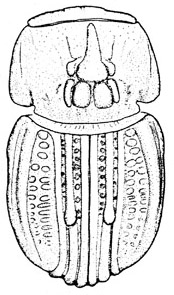 |
|||||
| ...Guide Home | Taxa Map | Keys to Taxa | Catalogs | Gallery | Search |
....SCARABAEOIDEA |
.... |
....Geotrupidae |
....Glaphyridae |
....Glaresidae |
....Hybosoridae |
....Lucanidae |
....Ochodaeidae |
....Passalidae |
....Pleocomidae |
....Scarabaeidae |
....Trogidae |
| XX |
|
XX | ||||||
X Classification status. In some tribal characters, the Stereomerini are similar to the Rhyparini. Yet, their body shape, pronotal and elytral structures, and body covering are very different. The only reported host for a stereomerine (Termitaxis Krikken) is with termites, another similarity. Distribution. Primarily found in extreme SE-Asia, Indonesia, and Australia. One described genus is reported from Peru. Composition. Worldwide there are 7 genera and 17 species in the Stereomerini. In the New world, only Termitaxis holmgreni Krikken is known. New World Genus (click on generic name for information) References: |
|
|||||||
|
 Termitaxis holmgreni Krikken Illustration from Krikken 1970. |
| Stereomerini menu |
| Type genus |
| Diagnosis |
| Classification status |
| Distribution |
| Composition |
| New World genera |
| References |
| Aphodiinae Overview |
| ....Entomology Home | Research | UNSM Entomology Database | Scarab Workers |
Authors: Paul
E. Skelley |
|||